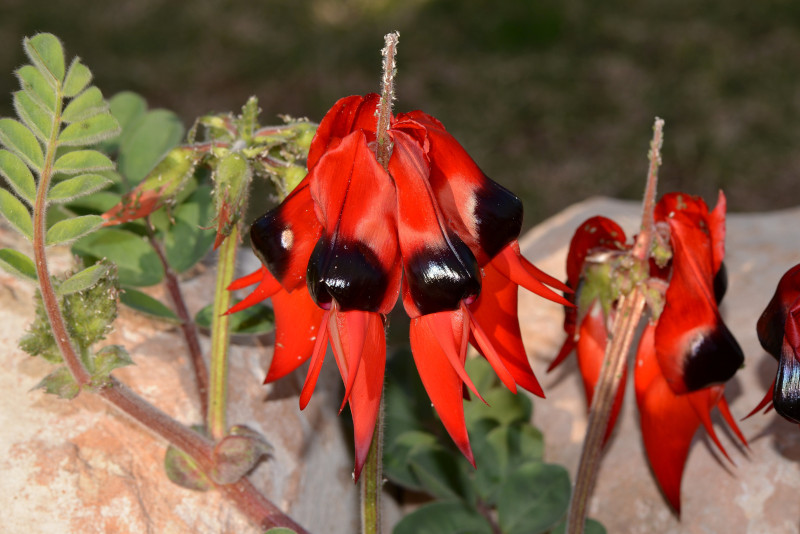
Sturt’s Desert Pea Facts
- This remarkable product of Nature and evolution most frequently goes by the somewhat unusual common name of the Sturt’s Desert Pea. Yet, it does have other, less often used general titles. These include such terms as glory flower and blood flower.
- Inside of the scientific community, however, it’s likely more often referred to by its technical label. Thankfully for the layperson, that’s a comparatively simple moniker to pronounce, at least as such things go. It holds formal eptithet of Swainsona formosa.
- Intriguingly, the official name it holds has changed multiple times since its discovery by modern researchers. William Dampier collected the first samples by a European explorer in 1699. Those specimens still exist today, preserved at Oxford University.
- In the 18th century, it received the tag Clianthus dampieri. Later, that changed to Clianthus formosus. Australian botanist Joy Thompson eventually gave it the honorific it holds today. The common name honors a British explorer of its native region.
- The distinctive Sturt’s Desert Pea appears to be maintaining a stable and sufficient population base. That fortunate condition further seems to hold true throughut the entirety of its range. It thus does not currently appear on the Red List of the IUCN.
- The marvel of Nature nevertheless should be considered to be facing several potential threats to its continued existence as a species, at least. Most of these stem from the actions of humans. They include the perils of habitat loss and climate change.
Related Articles
Sturt’s Desert Pea Physical Description
The intriguing Sturt’s Desert Pea almost immediate draws the attention of those fortunate enough to encounter it. That occurs due to several reasons, though. Certainly, its unsual appearance qualifies as one draw. Yet, the woody shrub also achieves a respectable size.
Mature specimens most typically reach a height equaling somewhere between 1.64 – 2.5 ft (0.5 – 0.75 m). The amazing plants tends to spread out, however. The flora therefore grows much wider than tall. An average measurement across ranges from 3.3 – 9.9 ft (1 – 3 m).
Surprisingly for may people, this wonderful Angiosperm actually classifies as a member of the pea family! Many of its basic physical characteristics thus accordingly resemble others of this group. Among those traits is the fact that the species evolved as a perennial.
Each specimen of this remarkable product of evolution produces multiple thin stems. These themselves each possess a relatively dense covering of short, thin white hairs. In basic coloring, this specific part of the unusual plant typiclly shows a light green shade.
The leaves of the Angiosperm develop along the stems, which generally remain prostrate. This foliage also displays the same covering of hairs as the stems. These appear in pairs, on opposite dies of the stem. In color, they usually show a dark, dull green shade.
It’s the flowers of the Sturt’s Desert Pea that distinguish it the most, though. Unlike the leaves, these develop on short, upright stalks. In length, they average about 3.5 in (9 cm). The blooms also generally manifest in groups of six to eight a each occurrence.
The petals develop as elongated and pointed, as well as most commonly a striking scarlet or blood-red in color. A most unusual large balck swelling additionally grows at the base of the petal. On rare occasions, however, other color varieties appear, such as white or pink.
- Kingdom: Plantae
- Phylum: Trachephyta
- Class: Eudicots
- Order: Fabales
- Family: Fabaceae
- Genus: Swainsona
- Species: S. formosa
Sturt’s Desert Pea Distribution, Habitat, and Ecology
The impressive Sturt’s Desert Pea evolved as native to a moderately large section of the earth’s surface. Given its unique nature, the location of that zone of habitation probably won’t surprise many of you. That’s because the flora developed as endemic to Australia.
Thankfully, within that range, the wonder thrives across the vast majority of the continent. The lone exception to this in this area seems to be the state of Victoria. It’s also absent from the neighboring islands associated with the continent as well, however.
Like many related plants, this marvel of evolution displays decidedly strong preferences regarding its choice of habitat. Normally, this kind of specialization serves to limit the flourishing on plants. Here, though, much of the region holds very similar environments.
The woody shrub generally makes its appearances in areas comprised of either open plains or relatively arid woodlands. It’s thus evolved to tolerate and even do well in the extremes of temperature common to such ecosystems. It also requires the soil to be well-drained.
The Sturt’s Desert Pea flowers from spring to summer. Pollination occurs almost exclusively via the actions of birds. Occurring in legume form, the fruit contains 50 or more kidney-shaped seeds. These also possess an extremely hard outer shell, which inhibits germination.
Yet, this also protects them. They sometimes lay dormant for years, until the next hard rain. At this time, the coat dissolves, allowing the seed to take root. Then, it quickly establishes a deep taproot, which aids in reaching water buried deep in its normal environment.
Species Sharing Its Range
Tree Kangaroo
Tiger Quoll
Check out our other articles on 5 Remarkable United States Reptiles, Eurasian Brown Bear, McMurdo Dry Valleys, Oceanic whitetip shark, East African Lowland Honey Bee, Purple Frog
